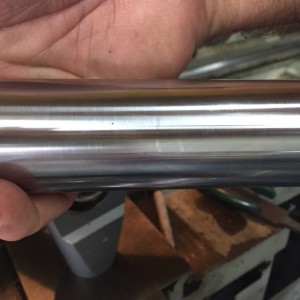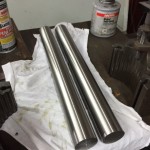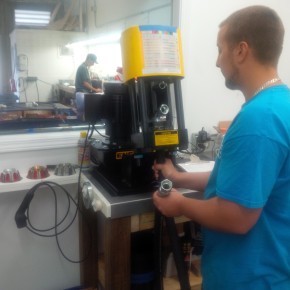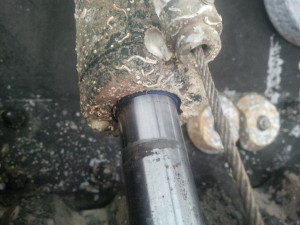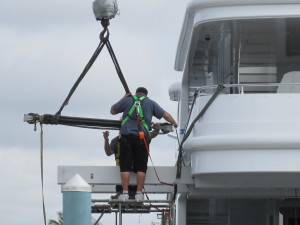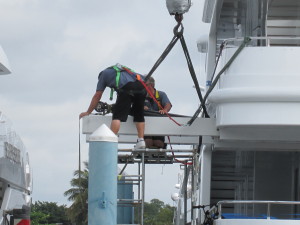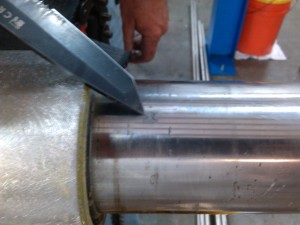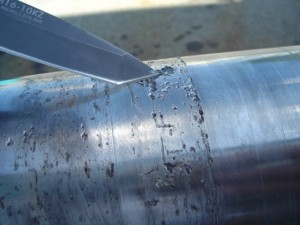We are seeing a growing number of new owners of older 112’ Westports. This “Made in America” production boat has a lot to offer but many of these vessels are purchased without a solid maintenance history. Nevertheless, their new owners/Captains still want to bring them back to life. In order to do that, sometimes a total refit of the vessel is required.
One of these new owner refits spent a few months at LMC getting a full paint job, mechanical upgrades, interior work and hydraulic systems overhaul and refurbishing. Our capable team of hydraulic technicians was tapped to handle all the hydraulic projects.
Starting with the Naiad stabilizer system, we did a full rebuild including removing the shafts and bearings. The entire stabilizer actuator system was also rebuilt back to new. The stabilizer shaft had some corrosion in the lip seal area from sitting too long in salt water so our on-site machine shop, Straight Line Marine, performed a cladding repair.
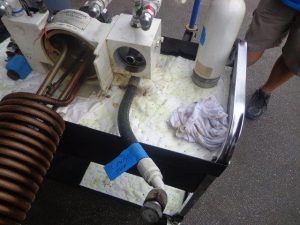 We then moved on to work on the entire hydraulic central system where we performed a full hydraulic fluid flush, cleaned and pressure tested the heat exchangers and changed all the filters.
We then moved on to work on the entire hydraulic central system where we performed a full hydraulic fluid flush, cleaned and pressure tested the heat exchangers and changed all the filters.
In the engine room, we found that we needed to change a large number of the hydraulic hoses. Hydraulic hoses have a 10-year life and can cause huge problems when they fail on the high-pressure side so it is very important to inspect and replace them during routine service.
We also did a little work on the bow thruster, installing new seals in the lower leg, adding fresh gear oil and testing the hydraulic motor.

Stainless steel ring on main gear
Our team did a full rebuild on the single Maxwell 4500 windlass on the bow, down to the gear box including installing new seals and bearings. As part of the rebuild, Straight Line Marine also fabricated new stainless steel rings for the main gears to help prevent future gear oil leaks around the lip seals. We also replaced the small Maxwell 2500 capstans in the stern with new electric units due to the cost of installing new versus re-building these smaller units.
We found the steering system to be in good shape. There were no leaks on the cylinders so these were left alone. We did, however, replaced a few hoses and upgraded some of the ball valves to stainless steel to help prevent future corrosion. Finally, we changed the fluid and filters.
This was a big job from start to finish but our talented hydraulic technicians, supported by our in-house machine shop, were more than capable of tackling every hydraulic system from bow to stern and everything in between.
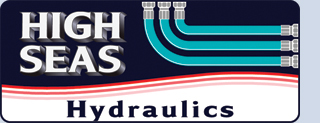




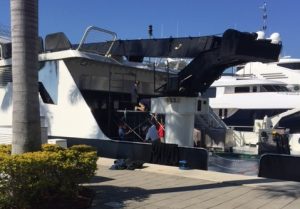
 for our hydraulic technicians to reach and secure the cylinders for removal from the boat. We then rented a boom truck with a 73 foot reach from a local business to remove the luffing cylinders from the yacht and place on our sister company,
for our hydraulic technicians to reach and secure the cylinders for removal from the boat. We then rented a boom truck with a 73 foot reach from a local business to remove the luffing cylinders from the yacht and place on our sister company, 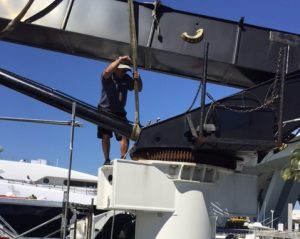
 attached to the boom truck crane. Installing the pin on a crane of this size takes balance and a little brute force! Once in place, we released the straps from the boom truck crane and using straps and the chain come-along ratchets, raised the luffing cylinders into place for securing the top to the crane. We then reattached the hydraulic hoses to the yacht’s crane so we could use the boat’s hydraulic power to extend the luffing
attached to the boom truck crane. Installing the pin on a crane of this size takes balance and a little brute force! Once in place, we released the straps from the boom truck crane and using straps and the chain come-along ratchets, raised the luffing cylinders into place for securing the top to the crane. We then reattached the hydraulic hoses to the yacht’s crane so we could use the boat’s hydraulic power to extend the luffing 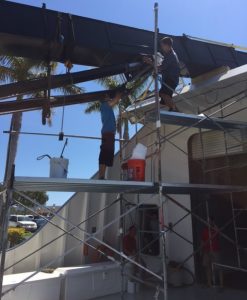 cylinders for the final pin installation. While this work takes experience and knowledge of the process, performing the task while standing on scaffolding more than 10 feet of the deck adds to the complexity.
cylinders for the final pin installation. While this work takes experience and knowledge of the process, performing the task while standing on scaffolding more than 10 feet of the deck adds to the complexity.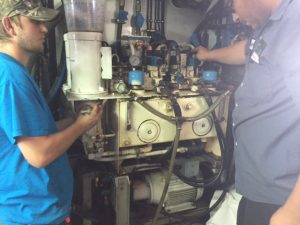 We next disassembled and removed the hydraulic power unit (HPU). The HPU consists mainly of a pair of motors, a reservoir tank and a hydraulic pump. These units can generate a tremendous amount of power to drive most any kind of hydraulic ram. Hydraulic Power Units are based on Pascal’s law of physics, drawing their power from ratios of area and pressure. In this case, the HPU takes the commands from the helm to push the hydraulic rods in the right direction to steer the yacht. A failure of the hydraulic steering system at sea or just about anywhere could prove to be catastrophic.
We next disassembled and removed the hydraulic power unit (HPU). The HPU consists mainly of a pair of motors, a reservoir tank and a hydraulic pump. These units can generate a tremendous amount of power to drive most any kind of hydraulic ram. Hydraulic Power Units are based on Pascal’s law of physics, drawing their power from ratios of area and pressure. In this case, the HPU takes the commands from the helm to push the hydraulic rods in the right direction to steer the yacht. A failure of the hydraulic steering system at sea or just about anywhere could prove to be catastrophic.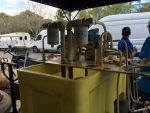 motors out for testing and tested all of the pumps to ensure they were in good working order. We also made all
motors out for testing and tested all of the pumps to ensure they were in good working order. We also made all 